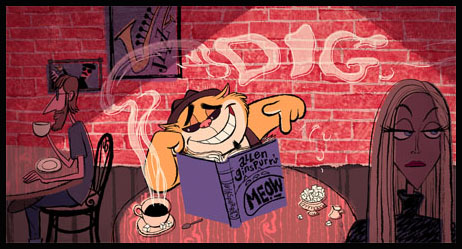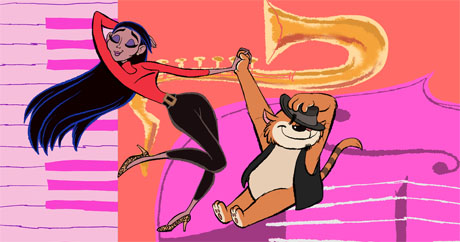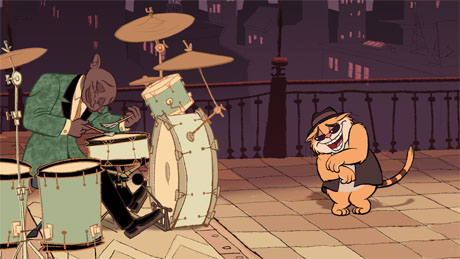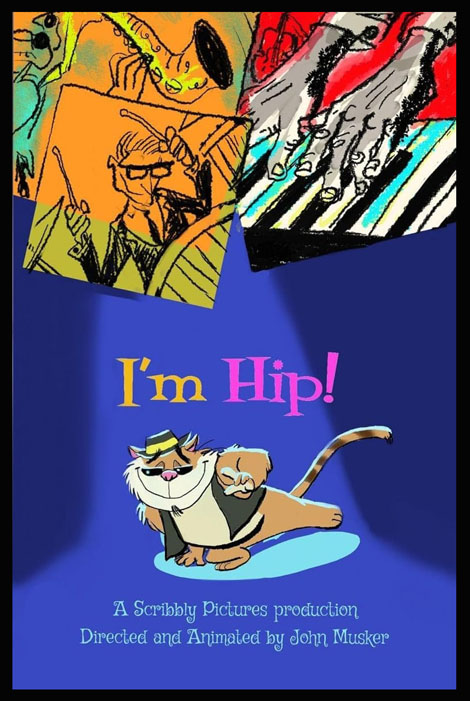John Musker is the director of some of the most beloved Disney animated movies of all-time, including The Little Mermaid, Aladdin, The Princess and the Frog and Moana. Those collaborations with co-director Ron Clements have brought joy to generations around the world. Musker left The Mouse House in 2018 with a goal in mind: to make his own short. He animated four-minute I’m Hip by himself. It’s the fast-paced saga of a cat enamored with jazz music and showing off his coolness to anyone he can, to the tune of a classic ’60s song. I’m Hip is now on the 96th Annual Academy Awards Best Animated Short Film shortlist. (This Animation Scoop Q&A with Musker was edited for length and clarity.) Images Credit: ©Scribbly Pictures
Jackson Murphy: Congratulations. I love the rhythm and feel of it. There are songs that I’ve listened to for a long time and are classics that I go back to. Were you a huge fan of the song? Do you remember the first time hearing this song and connecting to it?
John Musker: I don’t remember the first time hearing it, but I did hear it 30 years ago. The song was originally written in the ’60s by Dave Frishberg and Bob Dorough, for this singer, Blossom Dearie — a kooky jazz… piano player with a wispy voice. She performed in New York and then in Europe. I heard it years ago and thought, “The lyric is so funny. It’s very witty [and] sardonic.” I like the piano playing too. I had long harbored that this would make a great animated short. So when I retired from Disney a few years ago, my intention was to finally… do my own animated short. I used to be an animator, but I hadn’t animated in 35 or 40 years, so that was a little tricky. Had to re-learn it, sort of. This was somewhat cartoonier than… “The Fox and the Hound”, which I worked on. It was fun for me to do. I had to inquire to see if the rights [to the song] were available, and they were. I negotiated, and I got the rights. Bob died as I was starting to get the rights. That was a sad thing. His estate handled it. Dave was still alive when I got the rights. It took me four years to make this, and he died about halfway through making this. I hoped to show it to him. Through his lawyer, I got it to his widow, who liked it.

John Musker: When I was gonna do a short, I told my wife Gale I had a bunch of ideas. She said, “Do something funny.” I was like, “That’s good advice. Do something funny.” A lot of short films these days [including] on the festival circuit — which I’ve seen… brilliant work — a lot of it… most of it is not trying to be funny. I wanted to do something that would be fun to animate — fun on the page. And it’s sort of a love letter to hand-drawn animation. I love the art form. Making an actual cartoon was appealing to me. I tried to make it fun for the audience too — taking this very, very light, breezy romp through this funny song and get to enjoy this comic jazz and hand-drawn animation.
Murphy: It’s so vivacious and energetic. How do you organize the structure of it — visually or tonally? You have the lyrics of the song, but there’s so many quick scenes. It’s unbelievable.
Musker: There are a lot of quick scenes. I’m more aware of how quick it is as I’ve seen it with more audiences. The song, despite the fact that it is sort of a soliloquy, has a bit of a structure to it. It’s got verses, a bridge, a final wrap up and different sections in the song. I was inspired by a lot of what I heard in the song. Originally I just thought, “Okay, the narrator of the song is going to be the singer of the song. Should it be a person? Should it be an animal?” I drew some with a little funny-looking guy and some with a cat. In the animal world, somehow a cat seemed naturally cooler than a dog. I thought it would be more fun to animate a cat… a cartoon cat. The song had this wrap-up ending, and I thought it sounded like falling objects.
The cat is really a poser, in a way. He moves in that [jazz] world, but… he’s oblivious to the fact that he’s stepping on people along the way or putting himself in situations where people go, “What are you doing?” It’s a cat on a stage… and then you add more and more elements to it. I actually did an homage to Jim Flora. He did a lot of jazz album covers in the early ’60s, and he illustrated and wrote children’s books. I really wanted to celebrate full animation — overlap, drag, squash and stretch and volumetric drawing. It’s a drawing come to life… a little magic trick / slight of hand of animation. I always knew there would be cartoony gags, but no blood. Crazy, slapstick fun.

Murphy: It’s so alive. This cat thinks so highly of himself. What did you discover, in working on this for four years, what it means to be hip? Is it — or is it not — what the cat thinks?
Musker: I put cell phones in this because I wanted to not just be of a period. People who want to be hip never go out of fashion. You go to the ’20s, ’30s, ’40s… the 1890s. If you watch “Downton Abbey”, there’s people trying to be hip. It’s a constant thing… a desperate human need to not feel like you’re from some bygone era — that you’re fresh and cutting edge in whatever time that is. There is an element of desperation to it, at times, when it’s carried to its most extreme. The song chooses to look at it from a comic point of view, and that’s what I did too. “Please don’t leave me behind.” It’s a fight to remain young. To hold off death and decay. “I’m fresh! I’m alive! I’m not a relic! What I like is what everyone is gonna like!”
Murphy: You keep the fun going into the closing credits. You’ve directed some iconic animated movies, and so many animated movies over the years want to keep the audience engaged right through the credits — the list of the incredible people who worked on it and characters involved in different things. What did you want to accomplish with your credits here, and what goes into great credits for a short or a feature?
Musker: That’s something we did at Disney… we looked at every scene and sequence as an opportunity to do something entertaining. “How can I make this more engaging to the audience?” I always envisioned the credits would have to go at the end… and I had to find a piece of music because I didn’t want to reprise the same song. I’m a fan of Dave Brubeck, so I got [“Three to Get Ready”] to use at the end, and I licensed that. It had exactly the right tone. In terms of the visual styling… I want to keep the audience entertained in the spirit of the short. I want to go right to the last frame, with that gag [for the production company, Scribbly Pictures]. There are great title sequences… in “101 Dalmatians” and Brad [Bird’s] films. I thought of Dave Frishberg’s name in billiard balls. Talin Tanielan is my right-hand person. Every shot went through her. I thought it would be fun to have someone’s name spelled with ice cubes. You pour a drink and all the ice cubes rise to spell the name. I love the marriage of animation and music. I love “Fantasia”. I love all the Disney films with music, and the ones we did. The songs were always high points for Ron [Clements] and I. The idea of animating to a song is really appealing.

Murphy: It’s amazing how much goes into four minutes. Some people will just never understand. You’re a two-time Oscar nominee. Three of your films have been nominated for Best Animated Feature. How would it feel to be Oscar nominated again [for “I’m Hip”]?
Musker: There’s some really terrific shorts [this year]. I wasn’t sure I would make it this far. “The odds are long. There’s 93 shorts. 15 slots. Are you gonna be one of those 15? I don’t know.” Now there’s 15 shorts and there’s only five slots. Am I gonna make it to the next round? I don’t know. I may not. It would be a lot of fun. I’ve been to the Academy Awards. “Treasure Planet”, “The Princess and the Frog” and “Moana” were all nominated. Regardless of winning, for me, somehow if I manage to get nominated, to me that would be the win. I wasn’t trying to prove anything, necessarily, and yet I feel like… I did this without the studio infrastructure. I did this… with the help of great collaborators, but basically as sort of an independent filmmaker, I’m more along those ranks than I am a studio person. And we’re competing against at least one huge studio enterprise, which I think is good… but had resources that would dwarf any of the other [films’ budgets]. So I think of myself as an underdog and most of the films as underdogs in the competition. I’d be thrilled. I’d be very excited.







































